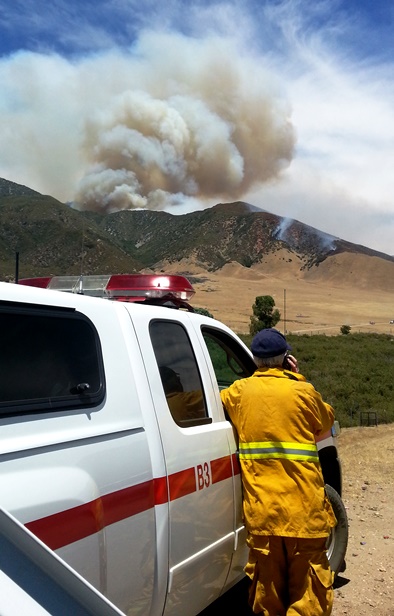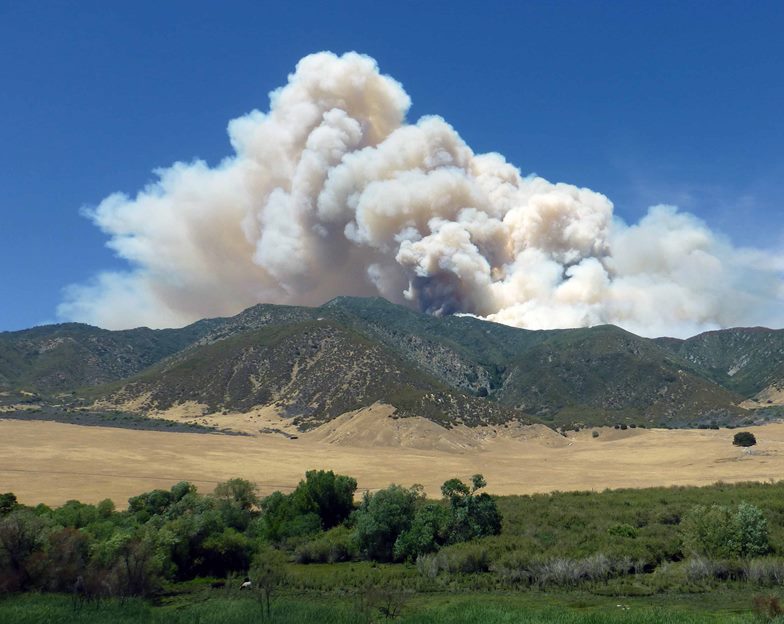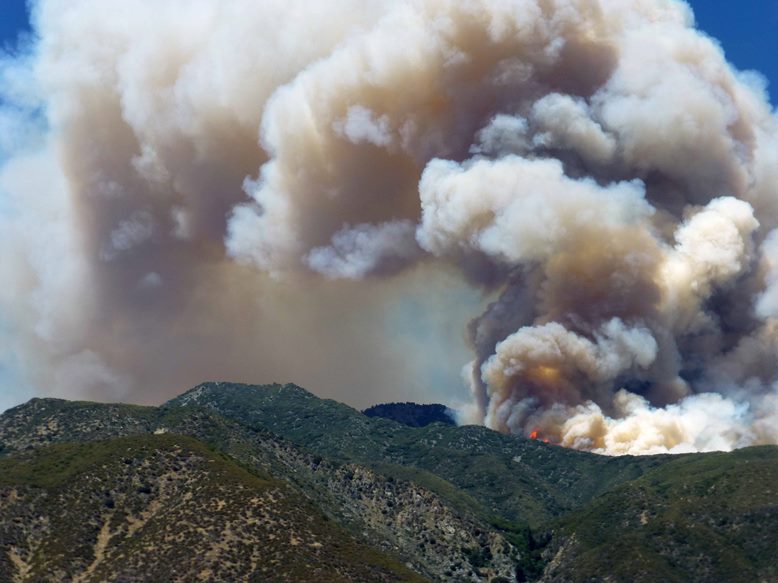Tag: California
Wildfire briefing, June 17, 2013
The worst wildfires
The Mother Nature Network has assembled what they call “10 of the Worst Wildfires in U.S. History”. Check it out to see if you agree with their list.
Furloughs cancelled for NWS
As wildfire season heats up the National Weather Service has cancelled their plans to force their employees to take four days off without pay before September 30. While a memo to all 12,000 NWS employees did not mention fire weather forecasts or Incident Meteorologists, it did refer to the tornadoes that plowed through Midwestern states last month. The Las Cruces Sun-News has more details.
Photos and videos of the 747 Supertanker, and a new CWN contract for the 20,000-gallon beast
Fire Aviation has some photos and videos of Evergreen’s 747 Supertanker that is receiving a new call when needed contract from the U.S. Forest Service. When you see the two photos of the 747 dropping on a fire in Mexico, compare them to this photo of a P2V dropping on a fire in the San Diego area Monday.
Denver post on the shortage of air tankers
The Denver Post has an article about the shortage of large air tankers in the United States and how that may have affected the early stages of the recent fires in Colorado. They also quote a very reliable source about the number of Unable to Fill (UTF) requests for air tankers.
Aspen Fire on Mount Lemmon, 10 years ago
It was 10 years ago today that the Aspen Fire ripped across the top of Mount Lemmon in Arizona, destroying nearly 340 homes and burning 84,000 acres.
Birds start fires in California and Nevada
A deluded conspiracy theorist might assume that terrorists have trained birds to fly into power lines and start fires, since over the last two days it happened in Chico, California and in Reno, Nevada. But in spite of the tin foil hat I’m wearing, I don’t think this quite meets the threshold for our Animal Arson series, since it is fairly common.
Smokejumper killed in northern California
(Originally published at 11:12 a.m. MT, June 11, 2013; updated at 12:30 p.m. MT, June 11, 2013)
The U.S. Forest Service has released the following statement:
****
“US Forest Service wildland firefighter dies in Northern California
Release Date: Jun 11, 2013
VALLEJO, Calif. – A 28-year-old firefighter from Susanville, Calif., died Monday afternoon [June 10] as a result of injuries received on a wildfire on the Modoc National Forest in northeast California. Luke Sheehy was a member of the California Smokejumpers, based out of Redding.
Sheehy was struck by a falling portion of a tree on the Saddle Back Fire in the South Warner Wilderness about 15 miles southeast of Alturas, Calif. The incident occurred just before 5 p.m. Efforts to resuscitate Sheehy were not successful. He was flown by helicopter to a hospital in Alturas where he was pronounced dead.
“Our hearts go out to the family and friends of this brave young smokejumper who lost his life yesterday working with his team to control a blaze on the Modoc National Forest,” said U.S. Forest Service Chief Tom Tidwell. “We are launching a full review into the cause of his death to learn everything we can to prevent future tragedies like this.”
Pacific Southwest Regional Forester Randy Moore echoed Chief Tidwell’s sentiments. “We are deeply saddened by this tragedy. It’s a devastating loss and is being felt throughout the entire Forest Service.”
The Saddle Back Fire is one of several dozen lightning-caused fires that began on multiple national forests throughout northern California on Sunday and Monday. It was first reported to the Modoc Interagency Communications Center about 3 p.m. Monday. Several U.S. Forest Service firefighters remain on scene suppressing the fire.”
(end of statement)
****
About 8,000 lightning strikes were recorded in northern California Sunday and Monday. As of Tuesday morning over 60 small fires had been detected.
Our sincere condolences go out to the family and co-workers of the jumper.
We will update this article as more details emerge.
Photos of the Hathaway fire
John Hawkins, Fire Chief of the CAL FIRE Riverside Unit & Riverside County Fire Department, who supplied us with the details of the Hathaway Fire photo in our “caption this photo” article, also sent us these two photos that he took of the fire just after 2 p.m. PT, June 9, about two hours after the fire started. Click on the photos to see larger versions.
Thanks Chief.
We are putting current information about the Hathaway fire in THIS article.
Caption this Hathaway Fire photo
(Originally published at 8:12 p.m. PT, June 10, 2013)
This photo of the Hathaway fire 80 miles east of Los Angeles was taken about two hours after the fire started on June 9. Unfortunately, there is no caption. Do you have any suggestions for a caption?
 (UPDATE at 7:50 a.m. PT, June 11, 2013)
(UPDATE at 7:50 a.m. PT, June 11, 2013)
Now, thanks to John Hawkins, Fire Chief of the CAL FIRE Riverside Unit & Riverside County Fire Department, we have an actual caption, but don’t let that inhibit you from suggesting one of your own. Here’s what Chief Hawkins told us about the photo:
The picture was taken about 1pm to 2pm [June 9] looking north from the ICP. The FF standing next to the pickup is Morongo Tribal Fire Department Fire Chief Tim Beadle. The pickup was the ICP for CAL FIRE Riverside Unit and Riverside County Fire Department Battalion Chief Jeff Stowells who, at that moment, was functioning as the sole IC.
Thanks Chief.
Fuels and fire behavior advisory for California
The following advisory for California was issued by “Predictive Services” today:
****
 Fuels and Fire Behavior Advisory
Fuels and Fire Behavior Advisory
California*
June 10, 2013
Subject: Low live and dead fuel moistures, along with persistent drought have created the potential for active to extreme fire behavior in many parts of the state.
Discussion: All of California is experiencing drought conditions. Effects of lower than normal live and dead fuel moistures and observed fire behavior for 2013 are the focus of this advisory.
Difference From Normal Conditions: Drought conditions ranging from abnormally dry to severe exist across California. The drought is expected to persist or intensify. The entire state is deficient in rainfall and snow pack, resulting in fuels that are 4-8 weeks ahead of normal drying/curing rates.
Concerns to Firefighters:
- Energy Release Component (ERC) at numerous weather stations set record highs already this year and running well above normal in most cases. Expect increased fire intensity and spread rates in these areas. Early season extreme fire behavior has been observed in both light and heavy fuels. Anticipate increased spread rates, spotting, and active night time burning.
- The combination of persistent drought and record-low rainfall and snowpack amounts has led to very low live and dead fuel moistures. Low 1000-hour fuel moistures have been evidenced by complete consumption of dead fuels on several recent fires. Live fuel moistures have already reached critical levels in many areas especially in Southern California. Expect fires to ignite easier and spread faster. Anticipate higher resistance to control in all fuel types.
- Excessively dry fuels and receptive fuel beds are resulting in fire behavior that is not deterred by what firefighters would consider normal barriers. Be mindful of what you use as a barrier or safety zone.
- Fires are burning actively even under conditions of high relative humidity. Already this year, California has experienced large fire activity and multiple team deployments. California will likely experience an extended fire season. It is important to be mindful of and manage fatigue for all resources.
Everyone, every day, returns home safely.
Mitigation Measures:
- Local and inbound fire personnel need to be aware that fire behavior across the state is exceeding normal expectations for this time of the year. Local briefings need to be thorough and highlight specific fire environment conditions. These include but are not limited to local weather forecasts, Pocket Cards, ERC’s, live and dead fuel moistures, and special fuel conditions such as mortality, Sudden Oak Death and frost killed brush, etc.
- Suppression actions need to be based on good anchor points, escape routes, and safety zones. Remember LCES. Experienced lookouts are essential under these conditions.
- Base all actions on current and expected behavior of the fire. Augment initial attack resources as incident activity dictates.
- Review the most current Northern and Southern California 7-day Significant Fire Potential along with Daily, Monthly and Seasonal Outlooks at: http://www.predictiveservices.nifc.gov/outlooks/outlooks.htm
*Area of Concern: The area of concern is the State of California with the exception of 3 Northern California Predictive Service Areas: North Coast, Northeastern, and Eastside. A map showing the areas of concern described in this advisory can be found at: National Fuel Advisories
Issued: June 10, 2013 (Note this advisory will be in effect for 14 days and will be reviewed/updated at that time.




